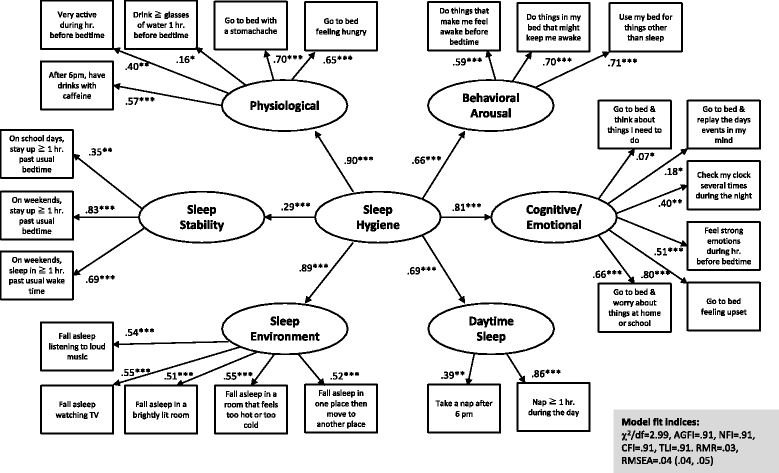Validation of the Farsi version of the revised Adolescent Sleep Hygiene Scale (ASHSr): a cross-sectional study
- PMID: 29282019
- PMCID: PMC5745592
- DOI: 10.1186/s12888-017-1578-6
Validation of the Farsi version of the revised Adolescent Sleep Hygiene Scale (ASHSr): a cross-sectional study
Abstract
Background: Restoring sleep is associated with a broad variety of favorable cognitive, emotional, social and behavioral benefits during the day. This holds particularly true for adolescents, as maturational, social, cognitive, emotional and behavioral changes might unfavorably impact on adolescents' sleep. Among adolescents, poor sleep hygiene practices are a potentially modifiable risk factor that can be addressed via appropriate interventions. Accordingly, having reliable and valid self-report measures to assess sleep hygiene practices is essential to gauge individual responses to behavioral interventions and evaluate sleep hygiene recommendations. The aim of the present study therefore was to translate and to test the psychometric properties (internal consistency, test-retest reliability, factorial and concurrent validity) of the Farsi/Persian version of the revised version of the Adolescent Sleep Hygiene Scale (ASHSr).
Method: A total of 1013 adolescents (mean age: M = 15.4 years; SD = 1.2; range: 12-19 years; 42.9% females) completed the ASHSr and the Pittsburgh Sleep Quality Index (PSQI) in their classroom during an official school lesson. Further, 20% completed the ASHSr 6 weeks later to evaluate the test-retest reliability. Cronbach's alpha coefficients were calculated to examine internal consistency, confirmatory factor analysis (CFA) was used to test factorial validity, whereas concurrent validity and test-retest reliability were examined via correlation analyses.
Results: A first-order confirmatory factor analysis (CFA) corroborated the six-factor structure of the ASHSr, including a physiological, behavioral arousal, cognitive/emotional, daytime sleep, sleep environment, and sleep stability factor. A second-order CFA showed that a higher-order sleep hygiene construct explained sufficient variance in each factor. Cronbach's alpha values ranged between .71 and .75, correlations for test-retest reliability between .82 and .87. Significant correlations were found between most ASHSr scales and the PSQI indices. However, the magnitude of these correlations was weak.
Conclusions: The Farsi/Persian version of the Adolescent Sleep Hygiene Scale can be used as a reliable and valid tool for evaluation of sleep hygiene practices among Farsi/Persian-speaking adolescents.
Keywords: Adolescent; Adolescents; Concurrent validity; Confirmatory factor analysis; Factorial validity; Internal consistency; Iran; Sleep hygiene scale; Test-retest-reliability.
Conflict of interest statement
Authors’ information
None.
Ethics approval and consent to participate
Participants and their legal guardians were informed about the aims of the study, and that all data would be gathered anonymously. Both participants and their legal guardians signed the written informed consent. The study was approved by the Review Board of the Kermanshah University of Medical Sciences (Kermanshah, Iran), and the study was performed in accordance to the ethical principles described in the Declaration of Helsinki. That is, participants received general information about the purpose of the study, about the voluntary basis of their participation, and about the confidentiality of their responses.
Consent for publication
Not applicable.
Competing interests
The authors declare that they have no competing interests.
Publisher’s Note
Springer Nature remains neutral with regard to jurisdictional claims in published maps and institutional affiliations.
Figures
References
-
- Brand S, Furlano R, Sidler M, Schulz J, Holsboer-Trachsler E. ‘Oh, baby, please don’t cry!’: in infants suffering from infantile colic hypothalamic-pituitary-adrenocortical axis activity is related to poor sleep and increased crying intensity. Neuropsychobiology. 2011;64:15–23. doi: 10.1159/000322456. - DOI - PubMed
-
- Hatzinger M, Brand S, Perren S, Stadelmann S, von Wyl A, von Klitzing K, Holsboer-Trachsler E. Sleep actigraphy pattern and behavioral/emotional difficulties in kindergarten children: association with hypothalamic-pituitary-adrenocortical (HPA) activity. J Psychiatr Res. 2010;44:253–261. doi: 10.1016/j.jpsychires.2009.08.012. - DOI - PubMed
Publication types
MeSH terms
LinkOut - more resources
Full Text Sources
Other Literature Sources
Medical


